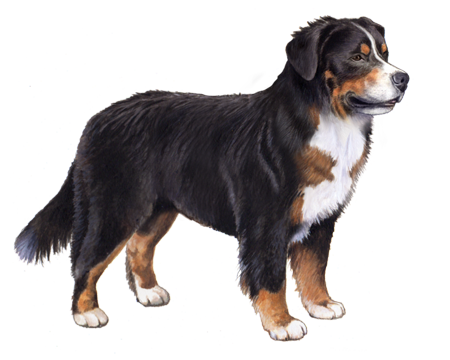
Saint Bernard
The Hollywood superstars of the dog world, these gentle giants make great nannies for children. Their caring and patient nature makes them a wonderful, but also massive, family member. They were bred to be mountain rescuers, and have an incredible history in the Swiss Alps.
Interested in discovering if your dog is a Saint Bernard?
Check out Wisdom Panel's DNA tests.

Saint Bernard Traits
General Appearance
A powerful workhorse of a dog, the Saint Bernard has a boisterous presence, and can be intimidating if not for their friendly and caring nature. They look intelligent, with a too-serious expression—like they are ready to save you at any instant!
Coat and Coloring
Bred in both longhaired and shorthaired varieties, Saint Bernards’ coats are thick, and will shed significantly once a year. They have white markings on their face and a white underbelly, while the rest of their coat is brown-yellow or red.
Distinctive Physical Traits
There is no mistaking the famously massive head and huge frame of the Saint Bernard. Coming in both long and shorthair varieties, they are very loving and caring companions. With their huge skull, powerful limbs, and long bushy tail – the Saint Bernard’s empowering presence is impossible to miss.
Saint Bernard Temperament
They have a playful and curious nature, but are always gentle. Saint Bernards can sometimes forget their size, and they love to snuggle with their owners. They do have some special care requirements, but they make excellent family members, particularly for families with young kids.


Saint Bernard History
Named after a Monk in the Swiss Alps, Bernard of Menthon, these dogs were created to rescue weary travelers. Established in 1050, The Saint Bernard saved people all along an 8,000-foot high pass for almost a thousand years.
The Swiss Alps saw particularly violent and harsh winters in 1816, 1817, and 1818. These dangerous conditions resulted in so many dogs giving their lives in service, the breed was almost driven to extinction. Monks were able to save the dogs by crossbreeding with Newfoundlands, and they saw an increased popularity in the UK in 1820.
The British began breeding their own version of the Saint Bernard in 1820, and there are now two breeds recognized by the American Kennel Club: the Saint Bernard and the English Saint Bernard. These dogs have a deep-seated desire to protect and ensure the safety of their companions.
Saint Bernard Care
Nutrition
Saint Bernards will need a high-quality food specially formulated for large breeds. They are large dogs, and they can be prone to overeating. Obesity is a big health concern for Saint Bernards, and caloric intake should be monitored.
Bloat is also a problem prevalent in this breed, and can be life threatening. To help prevent bloat, break their food up into several meals a day, and use a food bowl that’s specially designed to slow their rate of eating. When timing meals, avoid feeding them immediately after any kind of vigorous activity, and wait at least an hour after meals before allowing them to run or exercise. These are just a few of the ways you can mitigate this life-threatening condition. A veterinarian is the best resource for other recommendations, including surgical options, for preventing bloat.
Grooming
The Saint Bernard’s thick, bushy coat needs weekly brushing, and baths as necessary. When they shed, they will need brushing daily. The nails can grow quickly and should be trimmed if they’re not worn down with exercise.
All dogs require regular dental care, including at-home teeth brushing and professional dental cleanings, and Saint Bernard is no exception. Maintaining good dental hygiene is important for their overall long-term health.
Exercise
They are quite happy with a long walk, or thirty minutes of play every day. They are always happy to take nice long hikes, or to spend a night under the stars camping with their people. Particularly good with children, they make great companions for growing families.
Training
To ensure the safety of your Saint Bernard, early socialization and puppy training are a must. Teaching them not to jump is also important—obedience training can assist with that. They love to please their owners, which makes them very responsive to positive-reinforcement training methods.

Breed Group
Mountain Dogs
This genetic group was bred for hard work in mountainous regions. Characterized by their thick coats and sturdy, larger builds they quickly became the invaluable working companions of people in endurance activities such as drafting and hauling.






















